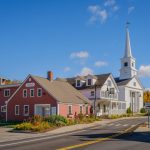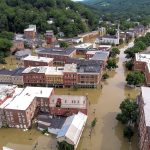Photo Salon for the Exchange of Ideas
Photography is the hottest medium in the art world at the moment and has been now for almost a decade. The accessibility of photo technology in a digital age is making it possible for a veritable army of artists to generate imagery for all intents and purposes. A Photo Salon As I’ve been writing monthly […]
Photography is the hottest medium in the art world at the moment and has been now for almost a decade. The accessibility of photo technology in a digital age is making it possible for a veritable army of artists to generate imagery for all intents and purposes.
A Photo Salon
As I’ve been writing monthly for Photo District News (PDN) since 1999, I was invited recently to a salon supper in Portland hosted by Heather Frederick of Vox Photographs, a new online photography gallery.
On a snowy Wednesday evening, I joined a half-dozen others for soup and a slide show in the seventh-floor apartment overlooking Portland City Hall, where Heather, who lives most of the time in Belfast with her husband, painter Linden Frederick, shows contemporary and vintage photographs by appointment.
Susan Danley, curator at the Portland Museum of Art; Anne Zill, director of the University of New England art gallery; Portland art dealer Dan Kany; and photographers David Brooks Stess and David Puntel braved the wintry mix and slick roads to share supper and attend a slide lecture by Brenton Hamilton of Maine Media Workshops.
Founded in 1973, Maine Media Workshops did business in Rockport as Maine Photographic Workshops until last year, when it became a nonprofit. The workshops offer some 250 courses a year, making Maine a mecca for photographers.
Hamilton surveyed the history of photography from 1900 to 1930 in some 50 slides, charting the evolution from stereopticon views through Pictorialism and the Photo Secession movements to the social documentary tradition in America and Modernism in Europe. He also explored the issue of the democratizing of photography as the cumbersome technology of glass and metal plates gave way to plastic Kodak film.
The liveliest part of the discussion that followed was over Vox Photography’s motto: “A photograph should always speak for itself.” Heather Frederick is of the purist mindset, believing that every viewer, sophisticated or naive, should be able to see whatever he or she sees in a photograph. I, on the other hand, feel that you can’t really understand an image unless you know something about the artist’s intent and the historical context in which it was created. Everyone knows what he or she likes, but very few people know why. There’s a big difference been enjoyment and appreciation.
Frederick’s Vox Photography represents nine contemporary photographers and also sells digital reproductions of vintage photographs by Anonymous, “my favorite photographer,” as Brenton Hamilton put it. One of the wonderful and disconcerting things about photography is that it’s possible for rank amateurs to take great photographs — just not with the consistency of professionals.
Hamilton’s talk about the sea change brought about by Kodak film reminded everyone of the current digital revolution, which makes everyone not only a photographer or videographer, but also photo editor and potential publisher. The more things change, the more they remain the same.
The three photographers at the gathering all participate in well-established traditions. David Brooks Stess is a New Yorker who has spent summers in Maine for 20 years raking blueberries and documenting the migrant workers in the black-and-white social documentary tradition. David Puntel, who is in the process of selling his Maine farm in order to move to Berlin (Germany, not New Hampshire), is a modern master of the antique ambrotype process. And Brenton Hamilton works in the even more arcane cyanotype process, producing modern photographs with classical themes.
As the world goes high-tech, there’s a small but determined and growing interest in returning to and preserving antique photographic processes — their laborious, handmade, often one-of-a-kind nature appealing to artists leery of the disposable ease with which digital images are made.
Of Frank and Friedlander
Along with a return to the mechanical processes of the past, there’s also a renewed interest in the photography of the past. Two great photography books arrived here within days of each other: one a modern classic; the other, more recent work by a classic American photographer.
Robert Frank’s landmark 1959 “The Americans” has just been reissued by Steidl, the German firm that is perhaps the world’s premier photo book publisher. The Americans ($39.95 hardcover) is arguably the single most influential photography book of the 20th century, its 83 grainy black-and-white photographs establishing an aesthetic that is still practiced and prevalent today.
Frank made the photographs in 1955-56 while traveling America on a Guggenheim grant. What he produced is the visual equivalent of Beat writer Jack Kerouac’s “On the Road”, so it was fitting that Kerouac, a native of Lowell, Massachusetts, wrote the introduction in his highly imitated hipster stream-of-consciousness style. The sad, sympathetic 1950s images of an American people in love with cars, televisions, celebrities, jukeboxes, and religion resonate with the America of today.
Robert Frank, 83, the deus absconditus of contemporary photography, has lived in relative seclusion in Mabou, Nova Scotia, for so long that it’s sometimes surprising to realize he’s still with us.
Lee Friedlander, 73, on the other hand, is very much with us and in evidence. Friedlander and the late Garry Winogrand were the godfathers of street photography, but Friedlander has remained amazingly productive to this day.
“Lee Friedlander Photographs: Frederick Law Olmsted Landscapes” (DAP, $85 hardcover) features 89 tritone photographs of landscapes designed by FLO, the greatest American landscape architect. Although these are all cultivated landscapes, Friedlander generally prefers their wilder environs, with a particular focus and grand, gnarled trees.
Among the New England landscapes featured are the Arnold Arboretum, Charles River, Charleston Heights, Franklin Park and Jamaica Pond in Boston, World’s End in Hingham, Massachusetts, Middlesex Falls in Malden, Massachusetts, and Cushing Island in Maine’s Casco Bay.
“Lee Friedlander: A Ramble in Olmsted Parks,” an exhibition of 40 of Friedlander’s Olmsted landscapes, is at the Metropolitan Museum of Art through May 11 should you be in Manhattan this spring.








Great article! I love the idea of a warm cup of soup and a friendly exchange of inspiration! And as for understanding the reasoning and story behind someone?s art, it is the reason why I love lurking around artists blogs! Isn’t the purpose of art to share an emotion, feeling or experience with the viewer? Or maybe it’s just for the process of creating? I’m not sure.
Oh, there are SO many things that I want to comment on, but I’m afraid I’d take up too much space. I’ll just leave it at thanks for sharing!?
Kelly
http://kellyschwark.com/
Kelly,
I’m glad you found Just Looking and enjoyed it. I just got home from seeing a major photography exhibition in Massachusetts that I’ll post some thoughts about in a week or so.
Ed
New into photography, very serioius about learning, I enjoyed reading your article, discovering photographers. I am linking your journal to my photoblog.
Betty
Betty, And I’m new at blogging. Where can I find your photoblog? Best, Ed
Ed my blog http://journals.aol.com/rap4143/MyDayMyInterests/. Enjoy. I hope you find the time comment on my journal.
Betty
Betty, I have checked out your blog several times. I enjoy the natural and personal feel of both your photographs and your blog.
Ed thank you for taking the time to visit my blog. My journal started, as my title reads, My Day, My Interests, naturally ended up as photoblog. http://journals.aol.com/rap4143/MyDayMyInterests/
I am learning photography also areas we visit. I absolutely love and enjoy traveling the back roads of New Hampshire and New England, always exploring for new photo opportunities. I found blogging allows me to share my photography, make new friends plus I welcome comments just saying hello or offering tips.
This past weekend we found and old grist mill located in East Alstead. (covered bridges, old barns, waterfalls and etc….a very good weekend of shooting) When we returned we had to learn about the history, name and what it was used for. Chase Mill http://millpictures.com/Mills/details.cfm?millid=39. I will be posting my images today.